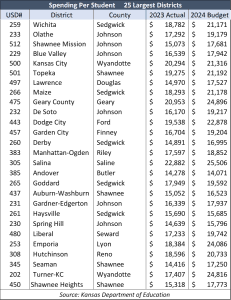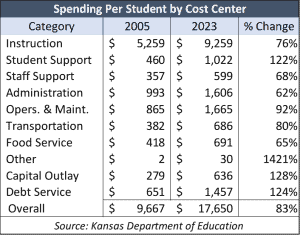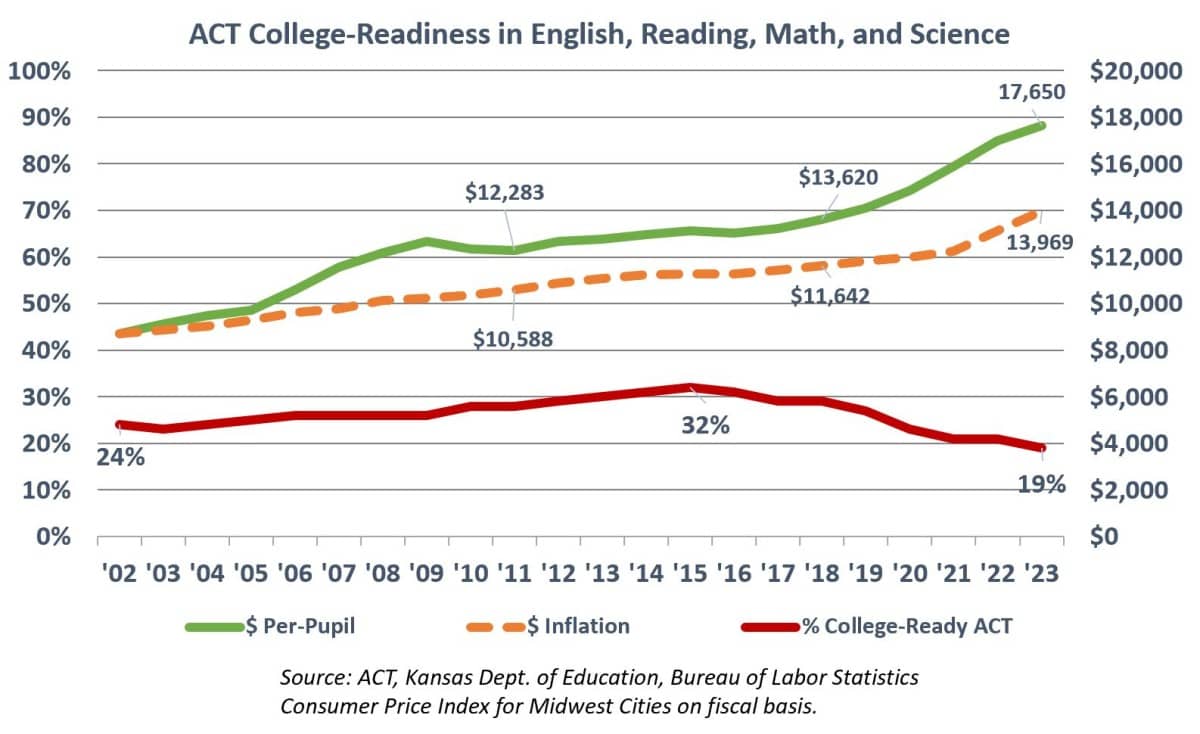New data from the Kansas Department of Education show school funding was $17,650 per student in the 2023 school year, but adjusted for the cost of living, spending is $20,195 compared to other states.
Data from the Missouri Economic Research and Information Center (MERIC), shows Kansas has the fourth-lowest cost of living in the nation, at 87.4% of the national average. A dollar buys a lot more in Kansas than in states like New York, so comparisons to other states must be adjusted for cost of living differences
Total school funding in the 2022-23 school year in the state went up by approximately $300 million to $8.2 billion.
State aid accounts for $5.2 billion ($11,202 per student), federal aid is $1.1 billion ($2,327 per student), and local expenditures are $1.9 billion ($4,121 per student), totaling — as previously noted — some $17,650 on average.
Spending for the previous school year was $7.9 billion, or $16,993 per student.
 A review of the 25 largest districts based on enrollment shows spending ranging from a little over $14,000 per student for Andover to almost $24,000 in Salina. Andover has considerable enrollment in its virtual learning program, and funding for those students is much lower. Spring Hill is another district with a large virtual learning program.
A review of the 25 largest districts based on enrollment shows spending ranging from a little over $14,000 per student for Andover to almost $24,000 in Salina. Andover has considerable enrollment in its virtual learning program, and funding for those students is much lower. Spring Hill is another district with a large virtual learning program.
USD 500 Kansas City and USD 475 Geary County also spent more than $20,000 per student, while Topeka and Dodge City exceeded $19,000.
Spending data for each district is downloaded from the Department of Education website and tabulated across all funds. Per-student amounts are based on full-time equivalent enrollment.
Details on each district’s actual spending for FY 2023 can be found here, and their budget reports are here.
Moreover, contrary to repeated claims by KASB that Kansas only began “increasing school funding more than inflation in 2018,” — total per-student spending has increased much more than inflation since 2005 (83% vs. 50%) and has consistently been higher than if increased by inflation each year, as shown on the chart below.
Additionally, the only actual cuts to spending since 2005 were initiated by former Democratic Governor Mark Parkinson; Parkinson concluded Gov. Sebelius’s term that ended in January 2011.
Only half of school funding goes to instruction
Spending is allocated across ten cost centers – Instruction, Student Support, Staff Support, Administration, Operations & Maintenance, Transportation, Food Service, Other Operating, Capital Outlay, and Debt Service.
 In 2005, the Kansas Supreme Court ordered an $853 million increase in funding to schools, and then-governor Kathleen Sebelius signed a public-policy statement passed by the Kansas Legislature calling on school districts to allocate 65% of total funding to Instruction.
In 2005, the Kansas Supreme Court ordered an $853 million increase in funding to schools, and then-governor Kathleen Sebelius signed a public-policy statement passed by the Kansas Legislature calling on school districts to allocate 65% of total funding to Instruction.
Had school districts complied with the Legislature’s policy, $12.2 billion more would have been spent on Instruction since 2005.
In 2005, districts allocated 54.4% of spending to instruction, but it was only 52.5% of school funding last year — the lowest allocation to instruction in 17 years.
All while achievement suffers and Kansas last school year turned in the lowest ACT scores in 30 years.
Before this latest drop in scores, 21 percent — below the national average — of Kansas students were considered “college ready” by ACT in English, Reading, Math, and Science. This marked a decrease from a high of 32 percent in 2015. At the end of the 2022-23 school year, only 19% are college-ready, with the national average at 21%.



